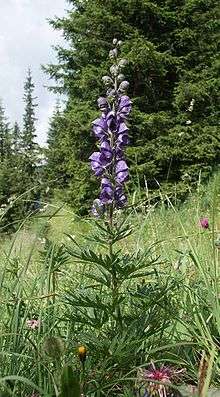Bane (plant)

The term bane (from Old English: bana, meaning "thing causing death, poison"),[1] in botany, is an archaic element in the common names of plants known to be toxic or poisonous.
In the Middle Ages, several poisonous plants of the genus Aconitum were thought to have or prophylactic qualities, repelling and protecting against that which they were banes to (e.g. Henbane, Wolfsbane).
Variants
There is no single species, genus, or family of poisonous plant exclusively referred to as banes. Several unrelated plants bear the name.
- Austrian Leopard's Bane
- Doronicum austriacum, it grows between approximately 60 and 90 centimetres high with a spacing of 45 to 60 cm. It prefers full sun exposure to partial shade, requires little water, blooms in late spring to early summer, and has a bloom colour of bright yellow. The propagation for this plant would be division of rhizomes, tubers, corns, or the bulbs including the off position of the seeds.
- Common Dogbane
- Apocynum androsaemifolium, a perennial herbaceous small shrub, growing up to one metre high, of the Apocynaceae family.
- Dog Bane
- Plectranthus ornatus a perennial in the Lamiaceae family, said to repel dogs from gardens. Grows to a height of about 24-36 in. The plant prefers full sun exposure and not to be over watered. P. ornatus has a bloom time of late summer, early fall to mid-fall and a bloom color of light blue, violet, or lavender.
- Leopard's Bane
- Doronicum orientale, also known as Little Leo. It grows between 40 and 46 cm high with a spacing of about 23 to 30 cm. All parts of the plant are poisonous if ingested. This plant is sensitive to the sun and over watering.
In culture
In medieval Europe, the toxic entheogen Aconitine was believed to prevent werewolves from undergoing their dire transformations.
In the Southeastern United States, sheep and cattle straying into woodland and grazing Kalmia latifolia have been known to suffer from its toxic effects.
Footnotes
- ↑ "Bane". Oxford Dictionaries. Oxford University Press. Retrieved 3 April 2013.